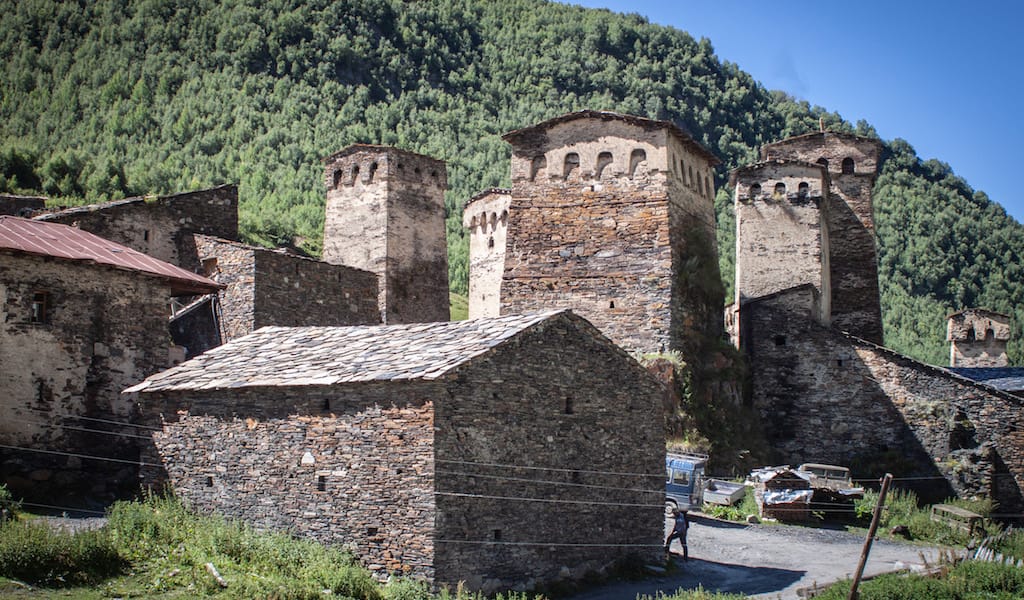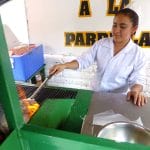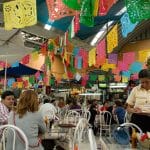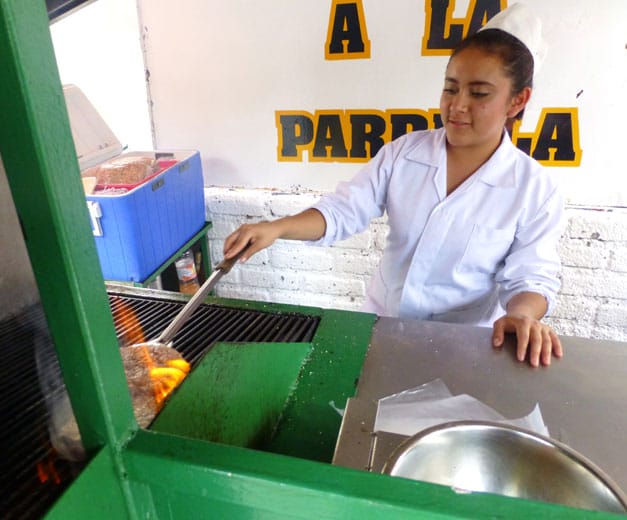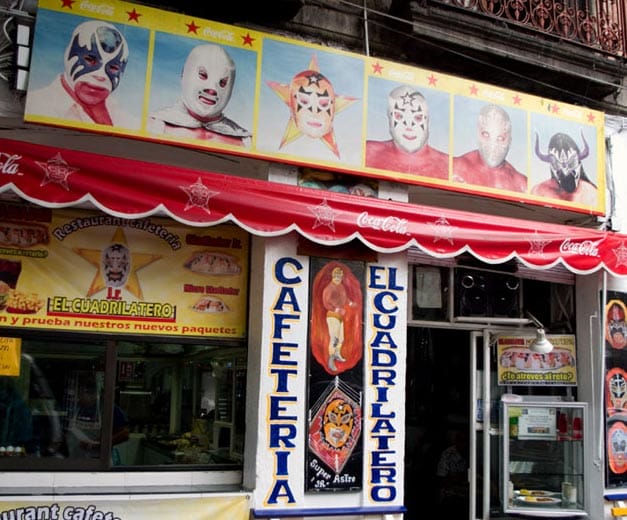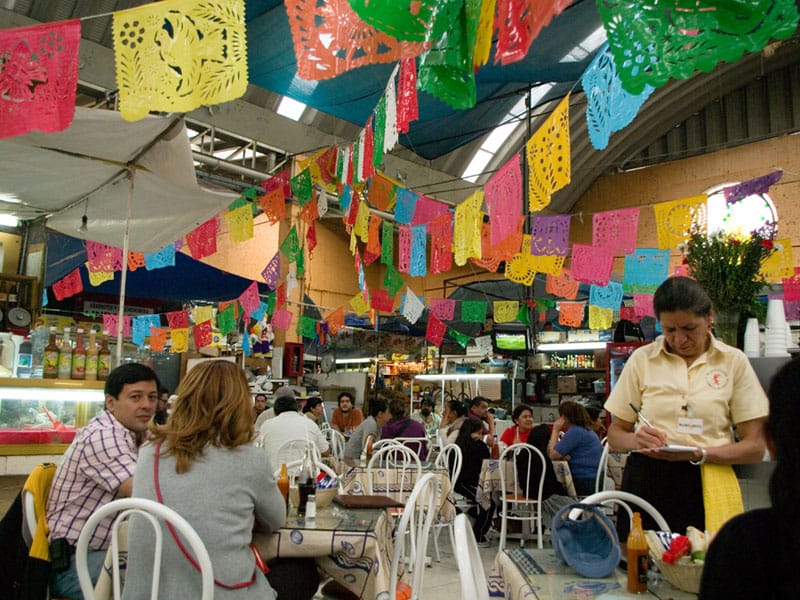It wasn’t so long ago that no one would venture to Georgia’s Svaneti region without a personal invitation, and even that was risky. Isolated, sky-high in the Caucasus, nestled between the breakaway territory of Abkhazia and the Russian Federation, it was land of the lost, inhabited by a tribe speaking their own language, living in hamlets dominated by tall medieval stone towers used for protection from invading hordes as well as from each other.
Ancient pagan-Christian rituals, bride-napping, blood vendettas and banditry defined modern Svaneti – at least when viewed from the outside. We had heard too many stories of how oblivious tourists would wander there with cameras around their necks and big tourist grins only to return in their underwear with their heads hanging low. Like Georgians from the rest of the country, we stayed away.
In the meantime, we managed to taste Svaneti occasionally in the form of a lusty blast of opulence called kubdari, a spiced meat pie native to the region that a few places in Tbilisi served. Georgians are masters of stuffed breads (some speculate there are 69 varieties) but only one is made with small bite-sized chunks of beef or pork or both, flavored with onion and savory indigenous seasonings.
Today we are in the Svanetian village of Ushguli, on a quest for the holy grail of kubdari. In the past dozen years, Svaneti has transformed from the most likely place to get waylaid to one of Georgia’s most popular tourist destinations. For Ushguli, one of the highest inhabited settlements in Europe, tourism is a mixed bag of blessings.
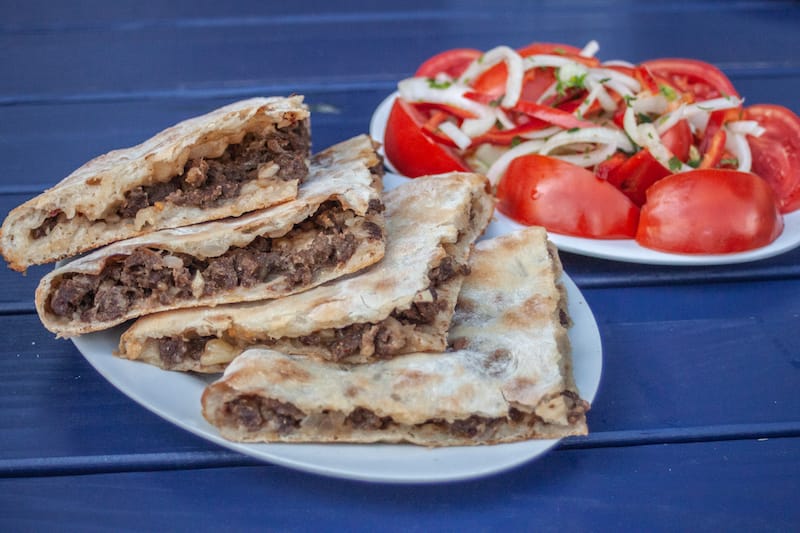
Only a couple hundred people populate the community year-round – snowed-in for half of it – living a bare-bones existence much like their ancestors have for centuries. Lowland Svans have always returned for the summer, but now Japanese four-wheel-drive vans deliver hordes of sightseers, who make good fodder for local wallets.
There are multi-story hotels with flushing toilets, guesthouse restaurants, canopies advertising beer companies and the plastic tables that go with them. Twelfth-century stone homes are fitted with plastic doors and insulated windows. This was not the kind of ancient Georgian rawness we were expecting to experience at 2,100 meters above sea level.
But we are here, after a bumpy two-hour drive through mud and streams and herds of cows, and take a seat at Café Lemi, a new wooden hut with a meadow as a dining area. We are awestruck, high on thin air, staring at Mt. Shkhara, Georgia’s highest peak, in the near distance. Behind us, a colt is milking from its mother under the 9th-century Lamaria Church while horses frolic in a neighboring field.
Café Lemi’s kubdari is well-seasoned, fatty enough to coat the inside of the leavened dough with succulence, but the mutt with squat legs lounging next to us gets the bits of beef we cannot chew.
There is no tradition of dry aging meat in Georgia, so beef, even when pounded with a mallet, is tough and more suited for stewing or grinding. Although it is nice to work out the deep savoriness of the Svanetian spices by chewing on it, our perfect kubdari should be entirely edible.
As it cooks in the oven, the juices release into the dough. A perfect kubadari cannot be too dry or soggy.
The next day we see what our digs, Hotel Panorama, has to offer. The owner, Eka, could use some extra hands running the joint, yet she remains upbeat and friendly. The guests are from all over: a group of female bicyclists from Spain, hikers from Germany, Holland and Serbia, and motorcyclists from hell who seemed to have ridden with their hair on fire. Her kubdari is decent, but nothing we would especially order again.
We then drove back down to Mestia, the regional capital. The last time we stayed here was in 2007, when you no longer had to worry about highway robbery. Guesthouses had just appeared, few with flushing toilets, and the history museum had recently opened. The idea at the time was to transform this gritty one-horse town into a tourist destination; all we could do was wish them luck.
Well, we barely recognized contemporary Mestia: guesthouses abound, as do restaurants, cafés, markets and a new theater building. You actually have to look both ways before you cross the street. At the top of a narrow cobblestone road that winds up to the Lanchvali district are the ancestral 12th-century towers of the Margiani family, one of Mestia’s most prominent clans.
Up here, Café Lanchvali serves Svanetian specialties like tashmijabi, a stretchy porridge made of sulguni cheese mixed into potato. The stretchier it is, the better. There is also chvishtari, cheese-stuffed patties of corn or traditional dark millet, which is as addictive as it is divinely earthy. Down in the kitchen, Melano Tsipiani, the head cook, slaps together a kubdari in less than a minute and slides it into the oven.
“Spices are key,” she explains. “Garlic, dried coriander, utkhos suneli [blue fenugreek], red and black pepper, dill, a little butter if the meat is dry, salt and Svan salt [a local blend of many of the mentioned spices].”
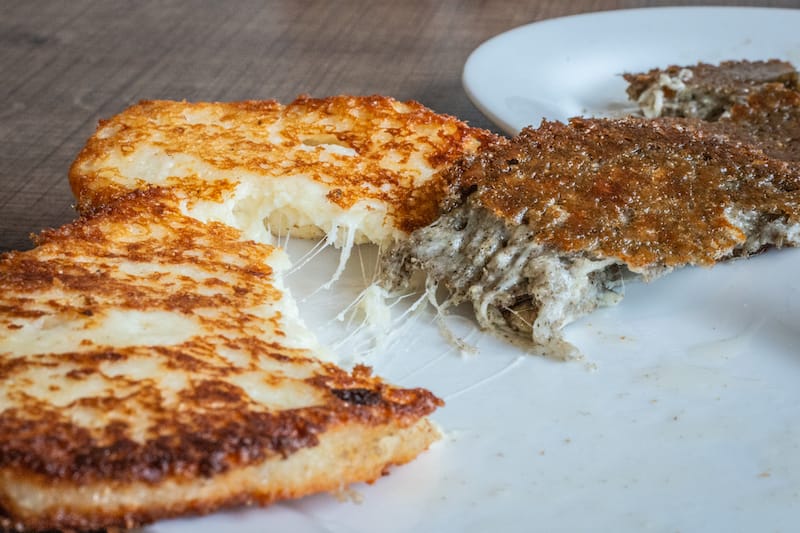
She uses about 250 grams of marinated meat per pie and stuffs it raw. As it cooks in the oven, the juices release into the dough. A perfect kubdari cannot be too dry or soggy. Miss Tsipiani has the touch, and has made our favorite pie so far.
Down off the main drag is Guesthouse David Zhorzholiani, the town’s very first. The owner, Datka, is a friend from way back, and we are sitting in the hotel courtyard next to a backgammon board talking food and drugs. We ask about a kubdari made with marijuana we have heard about and he nods his head.
“Gimshari,” he says. “With cheese. We all ate it as kids. It was so good.”
Marijuana, or hemp, was traditionally used for oil, rope and foods like khachapuri. But when it was cultivated for smoking and the government subsequently toughened up its drug laws, gimshari disappeared from people’s kitchens, to everyone’s disappointment.
Datka recommends Sunseti, a restaurant next to his hotel for kubdari. “It’s the best,” he assures us. While service was a bit awkward and confused we managed to get a kubdari delivered to our table. It was as succulent as Datka promised, but no better than Café Lanchvali’s.
On the way back towards the flatlands, we decide to stop at a clean looking roadside tavern with outdoor seating overlooking the Enguri reservoir. Although we are officially in the neighboring region of Samegrelo, the owners have kubdari and offer it with pork, which is sweeter than beef and contrasts well with the savoriness of the spices. Leaning back in the wooden chairs, rubbing our bellies, we agreed it rates high, but the mother of all kubdari it is not.
The hunt for the great meat pie in the sky was not a total failure. In our pursuit, we stumbled into timeless mountain settlements, discovered new dishes and flavors, and saw how people are restoring life to deserted communities. And we ate more kubdari in seven days than we have in seven years.
Published on August 15, 2019
Related stories
August 26, 2014
Mexico City | By David Lida
Mexico CityIn the past couple of years, in the fashionable neighborhoods of Mexico City, a panoply of high-class hamburger joints has opened. To delineate their distinction from anything to do with Mexico, most of them have names in English, and their menus offer burgers fashioned from ground sirloin, Kobe or Wagyu beef, with toppings as diverse…
October 14, 2014
Mexico City | By Ben Herrera
Mexico CityMexico City’s Centro Histórico is never a dull place. Combined with the massive crowds and the constant roar of honking horns, passing buses and shouting vendors, the sheer visual stimulus is enough to make one weak in the knees after an hour or so. It can be a huge relief to step off the street…
March 15, 2017
Mexico CityMexico City can be quite lacking when it comes to finding fresh, tasty seafood. At most markets in the city, in addition to the taco places and tlacoyo vendors, there is usually some kind of stand selling seafood, but the quality can be either very good or very bad. Buying from the right place is…







































